What was your favorite toy as a child … and why?
(Note: This is a good question to ask about your main characters.)

by James Scott Bell
@jamesscottbell
Some years ago I had the chance to meet and listen to the late Stephen J. Cannell. Cannell was, of course, the television wunderkind who created such shows as The Rockford Files, Baretta, The A-Team, 21 Jump Street, and others. He wrote at least 450 filmed television scripts. The guy had a Midas typewriter.
In the 90s he started writing crime fiction, then a series of books featuring LAPD detective Shane Scully.
So Cannell was on this panel with Robert Crais and T. Jefferson Parker. Someone asked him a writing question, and Cannell said something to the effect that he always asks, “What’s the bad guy doing?”
Even when the bad guy wasn’t “onstage,” Cannell would be pondering: “What’s the bad guy doing?”
It’s a great question! We writers seldom give the offstage players any mind. I’ve written before of the power of the “shadow story.” What’s the bad guy doing? is one of the key questions to ask in that regard.
Note: you don’t have to be writing about a true “bad guy” to ask this question. It applies to any antagonist.
Let’s say you were writing the novel that became the movie The Fugitive, starring Harrison Ford and Tommy Lee Jones (in reality the movie was based on the hit 1960s TV series starring David Janssen, created by Roy Huggins). In the movie Jones plays U.S. Marshal Sam Gerard. He’s not a bad guy. He is in fact a good guy who happens to be tasked with nabbing Dr. Richard Kimble and sending him back to Death Row.
Let us further suppose that you were writing the novel in First Person or Limited Third Person POV (where you stay with one character’s perspective throughout). You would be in Kimble’s head as he comes home to confront the one-armed man who murdered his wife. Then would come the trial and Kimble’s wrongful conviction.
Next, the prison bus mishap, the train crash, the escape! Then Kimble struggles through the night with his wound and his prison uniform. And you’d come to the next morning when he sneaks into the rural hospital to dress his wound, get some civvies, shave, and get out of there without being noticed.
All very tense. Good job, novelist!
Finally Kimble gets out of the hospital, but not before he is recognized by a wounded prison guard from the bus. To keep the guy quiet Kimble pushes an oxygen mask on his face. And as the paramedics rush the guard inside, Kimble tells them to let the attending doctor know the guy has a puncture in his upper gastric area.
Which causes one of them to ask, “How the hell does he know by looking at him?”
Kimble then hops in the ambulance and takes off.
Nice scene, there, writer! The opening act has been awesome!
But then you come to your project the next day and can’t figure out what to write next. If you’re a pure pantser, of course, you can write about anything. So you do a scene where Kimble falls into a giant hole that spits takes him back in time to the Battle of Little Big Horn. There he tries to save as many wounded as possible until…
Oh bollix, you think. I wish I’d done some outlining! And I wish I knew why I keep using the word bollix!
Now what?
Ask the Cannell question! “Hmm, what’s my antagonist doing while Kimble is at the hospital?”
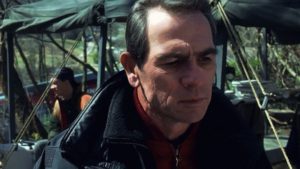 The nice thing about the movie is we get to see it. We cut back to Gerard at his command post, making plans. We see what kind of team and resources he has assembled.
The nice thing about the movie is we get to see it. We cut back to Gerard at his command post, making plans. We see what kind of team and resources he has assembled.
So back to the hospital. You’re thinking about what Sam Gerard is doing. You imagine him at the crash site, with his team gathered around him. Then one of his people runs up and says, “Hey, we just got a report. Kimble stole an ambulance!” What would Gerard do next?
Order a chopper! Let’s move!
Which gives you the idea for the next scene in your novel. Kimble looks up and sees he’s being chased from the air!
Way back when I was first trying to learn this craft of ours, and writing copious notes on what I learned, I jotted this down: Most of the craft of fiction is knowing what questions to ask at what time.
I still think that’s a pretty good insight. And What’s the bad guy doing? is a darn good question.
Do you know what yours is doing?
by James Scott Bell
@jamesscottbell
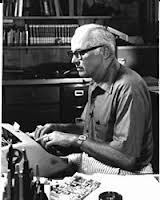 The late, great John D. MacDonald (author of the Travis McGee series, but even more enjoyable for me, a string of paperback originals in the 1950s) had a philosophy of writing. It’s found in the introduction to his short story collection, The Good Old Stuff:
The late, great John D. MacDonald (author of the Travis McGee series, but even more enjoyable for me, a string of paperback originals in the 1950s) had a philosophy of writing. It’s found in the introduction to his short story collection, The Good Old Stuff:
First, there has to be a strong sense of story. I want to be intrigued by wondering what is going to happen next. I want the people that I read about to be in difficulties–emotional, moral, spiritual, whatever, and I want to live with them while they’re finding their way out of these difficulties.
Second, I want the writer to make me suspend my disbelief. I want to be in some other place and scene of the writer’s devising.
Next, I want him to have a bit of magic in his prose style, a bit of unobtrusive poetry. I want to have words and phrases that really sing. And I like an attitude of wryness, realism, the sense of inevitability. I think that writing–good writing–should be like listening to music, where you identify the themes, you see what the composer is doing with those themes, and then, just when you think you have him properly identified, and his methods identified, then he will put in a little quirk, a little twist, that will be so unexpected that you read it with a sense of glee, a sense of joy, because of its aptness, even though it may be a very dire and bloody part of the book.
So I want story, wit, music, wryness, color, and a sense of reality in what I read, and I try to get it in what I write.
Isn’t that a nice credo for a writer? And JDM did put all that in what he wrote. Especially unobtrusive poetry, which is why he is still read today when most PBO writers have vanished into the mist.
Now, when it comes to style, we all have preferences. I know Isaac Asimov once explained that he developed a very plain style so he could just get on with telling the story. Maybe that’s the reason I haven’t read a lot of Asimov.
Ah, but Ray Bradbury! Now there’s a stylist. Check out Dandelion Wine or Something Wicked This Way Comes if you want to see what I mean.
 Recently I came across a pulp writer whose work I was unfamiliar with. Howard Browne wrote a series of mysteries under the pseudonym John Evans. They featured Chicago PI Paul Pine. Browne’s model was clearly (and, I believe, admittedly) Raymond Chandler. While Chandler stands alone in the pantheon of stylists, I enjoyed Browne’s unobtrusive poetry. Here are some samples from Halo for Satan (1948):
Recently I came across a pulp writer whose work I was unfamiliar with. Howard Browne wrote a series of mysteries under the pseudonym John Evans. They featured Chicago PI Paul Pine. Browne’s model was clearly (and, I believe, admittedly) Raymond Chandler. While Chandler stands alone in the pantheon of stylists, I enjoyed Browne’s unobtrusive poetry. Here are some samples from Halo for Satan (1948):
I shoved open the front door and went into a gloomy hall filled with last year’s air.
It wasn’t much of a room. About large enough to play solitaire if you held the cards close to your chest.
Her right hand was pointing a small blue-steel automatic at the sweet roll I’d had for breakfast.
“Hello there,” I said brightly. It took a little while to get the words out because they had to come all the way up from the cuffs of my trousers.
There was a faded housecoat wrapped primly around her shapeless body and a lacy pink dustcap sat drunkenly on graying hair that probably had already been combed once that month.
Describing his office building:
It was sandwiched between two modern skyscrapers that seemed forever to be trying to edge away from their neighbor. It had a deep lobby, narrow and dim, paneled in gray and white imitation marble, a pair of secondhand bird cages masquerading as elevators and a sullen air of decay. The upper halls smelled like a Kansas hayloft after two weeks of rain, and my fellow tenants ran the type of businesses that attracted more process servers than customers.
Delightful, eh? Well, I think so!
So how can you find your own unobtrusive poetry? A couple of tips:
First, notice things. I mean, notice them through the eyes of your POV character. Take time. Look around at the scene. Watch things happen in the theater of your mind. Make a list of what is seen.
Second, take several stabs at description. Experiment. Use up a whole page (or more if you’re really cooking) and have fun. I guarantee you’ll find some gold which you’ve tickled so she comes out laughing (a line of unobtrusive poetry from the film Treasure of the Sierra Madre).
You might also want to review my checklists for setting description and description of characters.
Now it’s your turn. Share some examples of style that you really like, or tell us about an authors who you love to read for the language.
by James Scott Bell
@jamesscottbell
And by today, I mean the date of this post. Because the only constant now is change!
If you’re in the writing game to make serious bank, or at least a good side income (and only “blockheads” never write for some kind of income, according to Dr. Johnson), then you need to keep up to date on industry developments.
Now is a good time to look, as reports about the first quarter of 2016 are coming in.
Traditional Publishing Sales Are Down
According PW, sales of adult print books fell 10.3% in the first quarter of 2016, compared to the first period of 2015, and ebook sales in the same category fell 19%. Regarding the latter, industry observer Mike Shatzkin says a big part of the problem is the pricing of ebooks by publishers:
High ebook prices — and high means “high relative to lots of other ebooks available in the market” — will only work with the consumer when the book is “highly branded”, meaning already a bestseller or by an author that is well-known. And word-of-mouth, the mysterious phenomenon that every publisher counts on to make books big, is lubricated by low prices and seriously handicapped by high prices. If a friend says “read this” and the price is low, it can be an automatic purchase. Not so much if the price makes you stop and think.
This puts publishers in a very painful box. When they cut their ebook prices, they not only reduce sales revenue for each ebook they sell; they also hobble print sales.
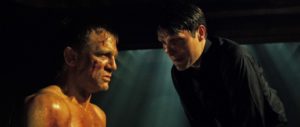 How much of this “pain” can the big publishers endure? Economics in a disruptive environment is merciless. Remember that scene in Casino Royale? (All the men do.) But also recall that Bond got out of it.
How much of this “pain” can the big publishers endure? Economics in a disruptive environment is merciless. Remember that scene in Casino Royale? (All the men do.) But also recall that Bond got out of it.
Barnes & Noble Barely Hanging On
The biggest bookstore chain has been closing stores and circling wagons. They’ve been emphasizing vibe (coffee house, browsing chairs) but not expanding shelf-space for books. Thus, says another article in PW:
Sales at Barnes & Noble fell 6.6% in the quarter ended July 30, compared to the same period last year. Revenue fell 6.1% in the company’s retail sector, and Nook revenue fell 24.5%. As a result of the lower-than-expected sales, B&N reported a net loss from continuing operations of $14.4 million in the period, its first quarter of 2017, compared to $7.8 million in the first period of fiscal 2016.
We all love bookstores. We hate to see physical shelf space shrink, and brick-and-mortar stores shuttered. A nice development is a rise in the local independent bookstore. Good! There are many cultural benefits to this uptick. However, the scale is small relative to a large chain, and breakout books by new authors cannot be driven on these tiny islands alone.
Meanwhile, Amazon Opens Another Physical Bookstore in San Diego
This to go along with their first such store in Seattle. And there are plans to open stores in Chicago and Portland.
According to industry observer Jane Friedman, here’s what you need to know about Amazon’s bookstores:
On this last point, a marketing professor quoted in the San Diego Union-Tribune says the intent is to “drive consumers deeper into the Amazon system.” The books “act as conversation starters with staffers, who can then teach customers about the benefits of [Amazon] Prime membership.”
Amazon has proven over and over again to be ahead of the curve, as they say, even though the curve these days is as formidable as that tossed by Mr. Clayton Kershaw. Amazon keeps staying in the batter’s box making contact.
What Should Writers Do?
This is a blog for writers, so the key question for me is always what do I and my fellow scribes need to be about in these turbulent times?
My drumbeat has always been: First, write the best book you can every time out! That’s why we emphasize craft here at TKZ. There is no substitute for quality. And if you can up your production, so much the better.
Next, turn your ear to wisdom, and your heart toward understanding (Proverbs 2:2). You need to decide what path to pursue as a writer, and how to do so with eyes open and good business practices. Thus:
Perspective #1 – Indie Writers
In a comment on the PW site, the estimable Hugh Howey said, in part:
The reality is that acquisitions and mergers have hidden the steady loss of market share by the Big 5, market share gladly gobbled up by self-published authors. Coloring books, plays, and rejected rough drafts have also helped the last two years, but it’s hard to rely on these things going forward. And publishers have to stop believing surveys that say people prefer print books. Yeah, the people who don’t read much do.
If the Big 5 are going to continue to guide their businesses by personal editorial tastes, celebrity tomes, and the whims of those who read (but probably don’t finish) 2 – 3 books a year, they’re in trouble. The real market for publishers should be the voracious readers who consume several books a week.
***
For authors, this time of flux is critical. As bookshelves dwindle, and B&N appears on the verge of going the way of Border’s, now would be a terrible time to take a work of art that lasts forever and sign it over to any publisher for term of copyright. The new standard has to be 5 to 7 years of license, or self-publish, until things shake out.
One ongoing debate is about whether an indie author should go exclusive with Amazon in order to take advantage of promotional opportunities (such as limited free pricing), and the page payouts of Kindle Unlimited. I think this is a great option for new writers who need to get eyeballs on their pages so they can begin building a readership. See the substantial discussion and links in the section on Kindle Unlimited in Jane Friedman’s post, mentioned above.
Perspective #2 – Traditionally Publishing Writers
For those writers in the midst of––or are hoping to land––a contract with a Big 5 or other traditional publisher, it’s long past the time when you can leave all contract negotiations to someone else. You must be informed. You need to know what to accept, what to reject, and where to compromise. Which also means knowing what your leverage is. If you are being represented by an agent, this is a conversation to have with them. (Oh, are you looking for an agent? Well, maybe one is looking for you. Keep track of the new agent alerts and other info at Chuck Sambuchino’s Guide to Literary Agents blog.)
Big tip: Don’t do any of this with a chip on your shoulder. Be polite and businesslike. But as the great Harvey Mackay counsels in Swim With the Sharks Without Being Eaten Alive, you need to know when to “smile and say no until your tongue bleeds.”
Mackay also says, “Make your decisions with your heart and what you’ll end up with is heart disease.” Don’t be so dreamy-eyed about being invited into the Forbidden City that you fail to make rational, long-term decisions.
A place to start is with attorney David Vandagriff’s book, The Nine Worst Provisions in Your Publishing Contract. Not only are important clauses explained, but Vandagriff (who is also known as the Passive Guy blogger) offers you strategies on how to make them better.
As I have stated several times, authors with a modicum of business sense (which is why I wrote How to Make a Living as a Writer) are the only corks on this roiling sea of change.
Be a cork. But be a smart cork. Subscribe to the Publishing Trends blog, which posts links to the “Top 5 Publishing Articles/Blog Posts of the Week.” Also consider a paid subscription to “The Hot Sheet” the twice-monthly industry dispatch written by the aforementioned Jane Friedman and journalist Porter Anderson.
Because information is now the coin of the realm. Get the info, digest it, use it. But don’t ever let it freak you out. Remember:
What about you? Where do you see the publishing industry going? How are you, as a writer, dealing with constant change?
by James Scott Bell
@jamesscottbell
Jessica Strawser, editorial director of Writer’s Digest magazine, and soon-to-be debut novelist, tweeted this from the recent WD conference in New York.
The day you think you know what you’re doing is the day you’ve lost your edge as a writer. @davidbaldacci #WDC16 pic.twitter.com/R2pCAVG3vs
— Jessica Strawser (@jessicastrawser) August 13, 2016
I agree. The dread mistake is called “mailing it in.” It’s when you think you’ve reached a certain point in your writing where you don’t have to improve. You’ve had some success, so why sweat and strain?
That’s not how a real writer thinks. How do I define a real writer? It’s someone who honors the craft and never settles. The real writer always sets the bar a bit higher than the last jump.
Mailing it in sometimes afflicts even the A list. A series that catches on in a big way can afford the author the opportunity to spend more time on a yacht than behind a keyboard. I’ve seen that happen a couple of times, and it’s not pretty.
On the other hand, you have a writer like Dennis Lehane. There he was with a popular PI series that he could have sat on. But then he proceeds to write one of the great stand-alone crime novels of our time, Mystic River. Not content with that, a few years later he writes an epic historical called The Given Day. I’m not sure he meant this to be a series, but I suspect the popularity of the novel gave rise to the idea. Now that series character, Joe Coughlin, is going to get the Ben Affleck treatment in a major motion picture.
I like what the Amazon “best books of the month” reviewer said about the second Coughlin book, Lived by Night: “Incredibly, Lehane … becomes more masterful with each book…”
That’s the kind of accolade for which a real writer strives. Because, you see, there is a joy and a satisfaction in the striving itself. The mail-it-inners don’t have that anymore. It’s a loss to the soul.
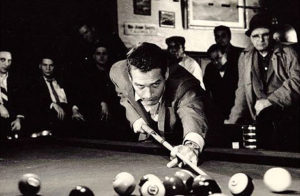 I’ve referred several times to that speech Paul Newman makes in The Hustler, one of my top ten favorite movies. He is “Fast Eddie” Felson, low-level pool hustler whose been told he’s a “born loser” by the satanic gambler played by George C. Scott. One day he describes to his girl, Sarah, what the game of pool feels like when “he’s really going.” It’s…
I’ve referred several times to that speech Paul Newman makes in The Hustler, one of my top ten favorite movies. He is “Fast Eddie” Felson, low-level pool hustler whose been told he’s a “born loser” by the satanic gambler played by George C. Scott. One day he describes to his girl, Sarah, what the game of pool feels like when “he’s really going.” It’s…
…like a jockey must feel. He’s sittin’ on his horse, he’s got all that speed and that power underneath him… he’s comin’ into the stretch, the pressure’s on ‘im, and he knows… just feels … when to let it go and how much. Cause he’s got everything workin’ for ‘im, timing, touch… it’s a great feeling, boy, it’s a real great feeling when you’re right and you know you’re right. It’s like all of a sudden I got oil in my arm. The pool cue’s part of me. You know, it’s a pool cue, it’s got nerves in it. It’s a piece of wood, it’s got nerves in it. You feel the roll of those balls, you don’t have to look, you just know. You make shots nobody’s ever made before. I can play that game the way nobody’s ever played it before.
Sarah looks at him and says, “You’re not a loser, Eddie. You’re a winner.”
Eddie looks at her quizzically. And she says, “Some men never get to feel that way about anything.”
Get it? Don’t ever settle for mailing it in.
Now how do you get to that “Fast Eddie feeling”? These things work for me:
Early in his career Dean Koontz was rolling along writing bestselling paperback thrillers under several pen names. But he wasn’t satisfied. So he set out to deepen his characterizations. He studied up on psychology and used what he learned to write Whispers. Would his wide audience for fast-paced thrills like it? It was a risk … and it became Koontz’s first New York Times bestseller.
So keep the edge. Make the writing itself (not just the results) the object of your affection. That way you’ll leave behind no regrets when your personal mail is delivered by the groundhog.
by James Scott Bell
@jamesscottbell
 I’ve never known a breath of life without Vin Scully in it.
I’ve never known a breath of life without Vin Scully in it.
Growing up in Los Angeles, and being a die-hard Dodgers fan, I spent my youthful summers listening to Vinnie (we all called him that, he was our favorite uncle or best friend) call the games via my transistor radio. Many a night I’d fall asleep to that honey-toned voice and my mom would have to tiptoe in and turn the radio off.
And now he’s about to retire. After 67 years behind the mike for the Brooklyn and Los Angeles Dodgers.
It’s like summer itself will no longer be there.
Everyone acknowledges Vin Scully as one of the greatest (JSB would say the greatest) sports announcers of all time.
The question for us today (and for writers) is, Why? I’d say three things:
His precision.
His poetry.
His passion.
Precision: Vinnie is always so prepared, able to talk about each and every player who comes up to bat. On both the Dodgers and the opposing team. He knows their stats, their backgrounds, and the particular stories that turn them into individuals and not just numbers.
He also knows when and how much of that information to give. One of the greatest Vin Scully traits is not over-talking, as so many announcers do. He often just lets the crowd chatter or cheer. It’s like he’s letting you be part of the game. Thus, you never get tired of hearing Vinnie’s voice (one of the most naturally gorgeous in all sports … or any other verbal art form known to man).
Poetry: Vinnie has always been able to weave lovely and often unforgettable phrases into his announcing. He often cites great literature and even popular songs. I remember one game he was calling over forty years ago where he referenced a Jim Croce song, saying, “Tonight, they are playing like a junkyard dog.” I’ve never forgotten that. That’s what Vinnie can do.
Passion: One thing for sure, Vin Scully loves baseball. More than that, he honors it. He knows the rich history of the game, the great players, the important moments. When you listen to Vinnie call a game you are getting more than an account of the innings; you’re getting a history lesson, too.
I just had to write about Vin Scully today, as a bittersweetness overtakes me for the end of an epic era. Maybe I always thought Vin Scully would be there …
And in a way, he will be. For he called my favorite sports moment of all time. And it is now preserved on YouTube. If you want to appreciate the genius, the greatness that is Vin Scully, watch that entire clip of the Kirk Gibson home run in Game 1 of the 1988 World Series.
You cannot overstate the drama. The Oakland A’s take a 4-3 lead into the bottom of the ninth inning. On the mound is the most feared closer in baseball, future Hall of Famer Dennis Eckersley.
Gibson, the Dodgers’ most valuable player (along with pitcher Orel Hershiser), couldn’t play. He’d injured both legs during the NLCS, and could barely walk, let alone run. But as the ninth inning rolled on, Gibson (in the clubhouse at the time) told manager Tommy Lasorda he could pinch hit if need be.
Which is when Tommy Lasorda faked out Eckersley and the A’s. With two outs, and Mike Davis at the plate, Lasorda put Dave Anderson in the on-deck circle. Eckersley decided he’d rather pitch to Anderson, and pitched around Davis, who drew the walk and trotted down to first base.
Then … suddenly … stunningly … out comes Kirk Gibson.
Watch the clip to see what happened.
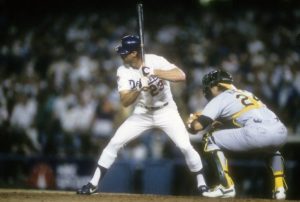 Vinnie, calling the game with Joe Garagiola for NBC, was as precise and colorful as always. At one point he describes Gibson “shaking his left leg, making it quiver, like a horse trying to get rid of a troublesome fly.” Perfect!
Vinnie, calling the game with Joe Garagiola for NBC, was as precise and colorful as always. At one point he describes Gibson “shaking his left leg, making it quiver, like a horse trying to get rid of a troublesome fly.” Perfect!
But what is so endearing about Vinnie and the home run is that his love of the game and its iconic moments couldn’t be held back. When Gibson’s ball cleared the right field fence, Vinnie for that instant became a fan himself. Not of the Dodgers, but of the game of baseball. He knew this was a moment on par with Bobby Thompson’s dramatic home run back in the 1956 pennant race, or Bill Mazeroski’s game 7 World Series winner in 1960.
So when Vinnie says, “She is GONE!” there’s a little extra oomph in the word gone that reveals the great one’s heart.
As Gibson rounds the bases, with the crowd going nuts, Vinnie lets the TV audience share the experience by saying not one word. He waits over one full minute, as Gibson’s teammates mob him, and then delivers one of the great lines in broadcasting history: “In a year that has been so improbable, the IMPOSSIBLE has happened!”
Writers, learn from the great Vin Scully.
Be precise. Yes, you can—indeed must—let your imagination out to play. But if you want to be a selling writer, at some point you must use the tools of the craft to shape readable fiction. Vin Scully is still one of the hardest working broadcasters in the game.
Be poetic. John D. MacDonald wanted “unobtrusive poetry” in his style. Not so much that it stuck out, shouting Look at this great writing! But more than plain vanilla. The latter can work, but why not reach for more? Vin Scully elevated every game with his prose.
Be passionate. Love telling stories. Joy is one of the big secrets of popular fiction. You can hear the love and joy in Vin Scully’s calls. Here is a man who had his dream job for nearly seven full decades. We always knew it.
Ah, Vinnie. I will miss you so much. You made my summers unforgettable. You transported me to the stadium when I couldn’t be there. And even when I was, I had my transistor with me so I could hear you call the game. So, I might add, did about half of Dodger Stadium.
And someday, when I write the best book of my life, and know it, and hit the key that publishes it, I want to hear your voice in my head:
“She is GONE!”
God bless you, Vin Scully.
So who were the voices of your childhood?
by James Scott Bell
@jamesscottbell
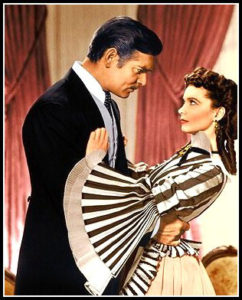 If you ever find yourself among a group of writers, writing teachers, agents or editors; and said group is waxing verbose on the craft of fiction; and the subject of what fiction is or should be rumbles into the discussion, you are likely to hear things like:
If you ever find yourself among a group of writers, writing teachers, agents or editors; and said group is waxing verbose on the craft of fiction; and the subject of what fiction is or should be rumbles into the discussion, you are likely to hear things like:
All fiction is character-driven.
It’s characters that make the book.
Readers care about characters, not plot.
Don’t talk to me about plot. I want to hear about the characters!
Such comments are usually followed by nods, murmured That’s rights or I so agrees, but almost never a healthy and hearty harrumph.
So, here is my contribution to the discussion: Harrumph!
Now that I have your attention, let me be clear about a couple of items before I continue.
First, we all agree that the best books, the most memorable novels, are a combination of terrific characters and intriguing plot developments.
Second, we all know there are different approaches to writing the novel. There are those who begin with a character and just start writing. Ray Bradbury was perhaps the most famous proponent of this method. He said he liked to let a character go running off as he followed the “footprints in the snow.” He would eventually look back and try to find the pattern in the prints.
Other writers like to begin with a strong What if, a plot idea, then people it with memorable characters. I would put Stephen King in this category. His character work is tremendous. Perhaps that is his greatest strength. But no one would say King ignores plot. He does avoid outlining the plot. But that’s more about method.
I’m not talking about method.
What I am proposing is that no successful novel is ever “just” about characters. In fact, no dynamic character can even exist without plot.
Why not? Because true character is only revealed in crisis.
Without crisis, a character can wear a mask. Plot rips off the mask and forces the character to transform––or resist transforming.
Now, what is meant by a so-called character-driven novel is that it’s more concerned with the inner life and emotions and growth of a character. Whereas a plot-driven novel is more about action and twists and turns (though the best of these weave in great character work, too). There is some sort of indefinable demarcation point where one can start to talk about a novel being one or the other. Somewhere between Annie Proulx and James Patterson is that line. Look for it if you dare.
We can also talk about the challenge to a character being rather “quiet.” Take a Jan Karon book. Father Tim is not running from armed assassins. But he does face the task of restoring a nativity scene in time for Christmas. If he didn’t have that challenge (with the pressure of time, pastoral duties, and lack of artistic skills) we would have a picture of a nice Episcopal priest who would overstay his welcome after thirty or forty pages. Instead, we have Shepherds Abiding.
If you still feel that voice within you protesting that it’s “all about character,” let me offer you this thought experiment. Let’s imagine we are reading a novel about an antebellum girl who has mesmerizing green eyes and likes to flirt with the local boys.
Let’s call her, oh, Scarlett.
We meet her on the front porch of her large Southern home chatting with the Tarleton twins. “I just can’t decide which of you is the more handsome,” she says. “And remember, I want to eat barbecue with you!”
Ten pages later we are at an estate called Twelve Oaks. Big barbecue going on. Scarlett goes around flirting with the men. She also asks one of her friends who that man is who is giving her the eye.
“Which one?” her friend says.
“That one,” says Scarlett. “The one who looks like Clark Gable.”
“Oh, that’s Rhett Butler from Charleston. Stay away from him.”
“I certainly will,” says Scarlett. (The character of Rhett Butler never appears again.)
Scarlett then finds Ashley Wilkes and coaxes him into the library.
“I love you,” she says.
“I love you too,” Ashley says. “Let’s get married.”
So they do.
One hundred pages later, Scarlett says, “I really do love you, Ashley.”
Ashley says, “I love you, Scarlett. Isn’t it grand how wonderful our life is?”
At which point a reader who has been very patient tosses the book across the room and says, “Frankly my dear, I don’t give a damn.”
What’s missing? Challenge. Threat. Plot! In the first few pages Scarlett should find out Ashley is engaged to another woman! And then she should confront him, and slap him, and then break a vase over the head of that scalawag who looks like Clark Gable! Oh yes, and then a little something called the Civil War needs to break out.
These developments rip off Scarlett’s genteel mask and begin to show us what she’s really made of.
That is what makes a novel.
Yes, yes, you must create a character the readers bond with and care about. But guess what’s the best way to do that? No, it’s not backstory. Or a quirky way of talking. It’s by disturbing their ordinary world.
Which is a function of plot.
So don’t tell me that character is more important than plot. It’s actually the other way around. Thus:
Do these things and guess what? You’ll be a plotter! Don’t hide your face in shame! Wear that badge proudly!
by James Scott Bell
@jamesscottbell
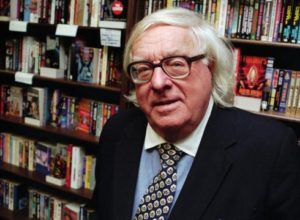 Our Reader Friday this week paid tribute to the late, great Ray Bradbury. He lived in L.A. so I got to hear him speak on a number of occasions. One time I got to meet him.
Our Reader Friday this week paid tribute to the late, great Ray Bradbury. He lived in L.A. so I got to hear him speak on a number of occasions. One time I got to meet him.
This was back when I was an unpublished writer unsure if I had the goods. Two books that had helped me keep my hopes up were Brenda Ueland’s If You Want to Write and Ray Bradbury’s Zen in the Art of Writing.
Bradbury was set to speak at the Woodland Hills branch of the Los Angeles Public Library, the very branch I grew up in. I couldn’t wait. I’d gobbled up The Illustrated Man in junior high school, and it was one of those transcendent reading experiences you get only once in a great while. This collection of stories is a glorious imagination on fire. It certainly turned up the heat on my own nascent desire to someday write stories myself.
So I took my well-thumbed and underlined copy of Zen to the library and settled in with a packed room. Bradbury arrived, walking slowly and wearing his white hair long and a bit wild. His hair was a metaphor for his writing approach––let it go, untamed, and put off a neat cut for as long as possible. “Time enough to think and cut and rewrite tomorrow,” Bradbury wrote in Zen. “But today––explode––fly apart––disintegrate!”
Bradbury spoke about his love of libraries, and it was great to hear from his own lips the well-known tale of how he wrote Fahrenheit 451 on a rented typewriter in the basement of UCLA’s Powell Library. (You can hear the man himself tell that story here.)
Then he talked about writing, and I took notes. Here they are:
He signed books after his talk, so I stood in line with my treasured copy of Zen. I introduced myself and we shook hands.
“Are you a writer?” he asked.
I quoted from the book: “‘Stay drunk on writing so reality cannot destroy you.'”
He laughed and said, “Oh, you must!”
I asked him if he set himself a daily quota, and he said, “I let my love determine how much I write.”
“Ah, so you fall in love daily?”
“That’s right.”
He signed my book. “Do you write every day?” he asked.
“Five days a week,” I said. “Weekends are for my family.”
He laughed again. “That’s the way to do it!”
He offered his hand once more and said, “God bless you.”
And off I went into the night, feeling blessed indeed for having had the chance to chat with one of the legends of our literature –– Ray Bradbury, American original.
Have you had the chance to talk to an author you admire? Who would be at the top of your list of writers you’d love to meet?
by James Scott Bell
@jamesscottbell
Hard to believe it’s been seven years frolicking in the blog fields of Kill Zone.
Seven years of putting out a regular Sunday post on writing and the writing life. With time off for good behavior (i.e., our regular Christmas break), I’ve done about 350 posts.
My first post was on July 26, 2009. I was so pleased to have been invited to join the regular crew, which at that time was made up of Kathryn Lilley, Joe Moore, John Ramsey Miller, Michelle Gagnon, Clare Langley-Hawthorne, and a fellow named Gilstrap. Good times! And they’ve only continued.
It’s been so cool to watch our readership grow, attesting to the quality of our contributors, both present and emeriti. Writer’s Digest and several online sites have taken notice of this, handing us their highest recommendations. We also have a robust community in our regular readers, who consistently post superb insights in the comments.
So how on earth does somebody come up with 350 topics on writing without repeating himself?
I’ll tell you: It’s easy if you love what you write about, and I love the craft of fiction. It’s endlessly fascinating to me to dig in and analyze what writers do and how they do it. I can write about the same topic –– for example, scenes or dialogue –– because I’m always noticing new things that work. I get excited because I can apply what I learn to my own writing, and then share it with others.
I also enjoy, from time to time, taking a look at the publishing industry. I came aboard TKZ just as digital self-publishing was starting to boom. In January of 2010 I wrote my first post on this topic right after Amazon announced its 70% royalty for indie authors. Looking back, I modestly note that my analysis seems pretty right on, except in one regard –– how the traditional publishers would react. I saw a great opportunity for new partnerships with authors. But the industry dug in and in many cases tried to prevent their authors from self-publishing anything.
Then came what I called The Eisler Sanction in March of 2011. That’s when everybody began to recognize that self-publishing was here to stay and that Amazon was going to be the 800-pound gorilla.
I’ve also posted the occasional personal reflection. I think it’s important that those of us who’ve been around the block, so to speak, give newer writers the benefit of our experience. There isn’t a writing obstacle or mental hurdle a writer faces that we here at TKZ haven’t gone through ourselves.
For the record, the post that got me the most hits was The Ten Events of the Highly Successful Writer.
Seven years!
And you know what? I’m ready for another seven. I’ve got a dozen ideas already queued up. And if this blog lasts, and the creek don’t rise (not really an issue here in Southern California), I’ll be coming up with many more.
Thanks to my blogmates for their consistent professionalism over the years. And thanks to you, our loyal readers, for helping make TKZ one of the premiere spots for writers to hang out.
So what brought you to Kill Zone for the first time? Any reflections on the site you’d like to share?